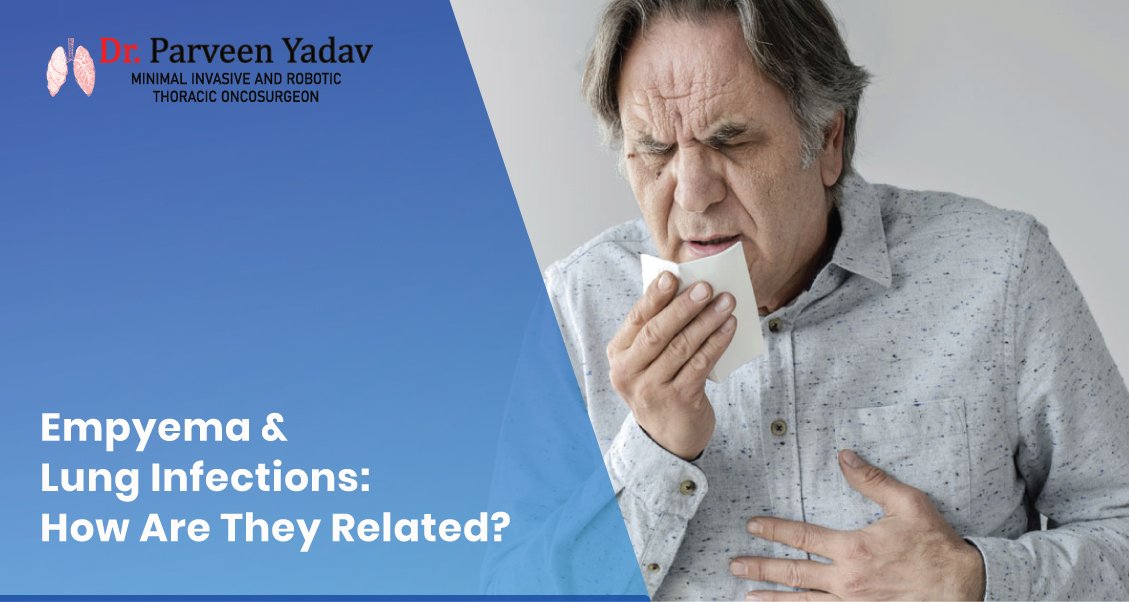
Empyema and Lung Infections: How Are They Related?
Empyema is a serious condition characterized by the accumulation of pus in the pleural cavity the space between the lungs and the chest wall. It is often associated with lung infections, especially Pneumonia, and can lead to severe complications if not treated promptly. This article explores the relationship between empyema and lung infections, highlighting their causes, symptoms, diagnostic methods, and treatment options to offer a comprehensive understanding for patients and caregivers.
What is Empyema?
Empyema directs to the collection of pus in the pleural space, which is normally filled with a small amount of fluid to lubricate lung movement. When an infection spreads to this space, it can result in empyema, making it difficult for the lungs to expand and function properly.
Types of Empyema:
- Simple Empyema: Early stage with thin, free-flowing pus.
- Complicated Empyema: Advanced stage with thicker pus and fibrous tissue formation.
- Chronic Empyema: Long-standing infection leading to scarring and lung damage.
The Link Between Empyema and Lung Infections
Lung infections, especially bacterial Pneumonia, are the leading cause of empyema. When Pneumonia is severe or not treated properly, bacteria can spread from the lung tissue to the pleural cavity, causing an inflammatory response that leads to pus formation.
Other lung infections, including tuberculosis, lung abscesses, and bronchiectasis, can also result in empyema. These infections compromise the immune system’s ability to clear bacteria, increasing the risk of complications like pleural infection.
Common Causes of Lung Infections Leading to Empyema
- Bacterial Pneumonia:
- The most common cause of empyema.
- Pathogens: Streptococcus pneumoniae, Staphylococcus aureus, and Klebsiella pneumoniae.
- Tuberculosis:
- Chronic lung infection is caused by Mycobacterium tuberculosis, which can extend into the pleural space.
- Lung Abscess:
- A localized infection within the lung that can rupture into the pleural cavity, leading to empyema.
- Post-Surgical or Traumatic Infections:
- Chest surgeries or penetrating trauma can introduce bacteria, causing empyema.
Signs and Symptoms of Empyema and Lung Infections
Symptoms of Lung Infections (e.g., Pneumonia)
- Fever and chills
- Productive cough with green or yellow sputum
- Shortness of breath
- Chest pain that aggravates with breathing or coughing
- Fatigue and weakness
Symptoms of Empyema
- Persistent chest pain
- Shortness of breath that worsens over time
- Fever that does not resolve with antibiotics
- Cough with little or no sputum
- Weight loss and general fatigue
- Night sweats
Empyema symptoms often develop after an initial lung infection has started to improve, but the fever and respiratory distress return or worsen, indicating that the infection has spread.
How Are Empyema and Lung Infections Diagnosed?
- Physical Examination:
- Doctors listen for decreased breath sounds or dullness during chest percussion, which may suggest fluid buildup in the pleural space.
- Chest X-Ray:
- It can reveal fluid accumulation in the pleural cavity, indicating possible empyema.
- Computed Tomography (CT) Scan:
- Provides detailed pictures of the lungs and pleural cavity, helping to differentiate between Pneumonia, abscesses, and empyema.
- Ultrasound:
- Used to detect free-flowing or loculated fluid in the pleural space.
- Thoracentesis (Pleural Fluid Analysis):
- A sample of pleural fluid is obtained and analyzed for pus, bacteria, and inflammatory markers to confirm empyema.
- Blood Tests:
- Raised white blood cell counts and inflammatory markers (like C-reactive protein) indicate infection.
Treatment of Empyema and Lung Infections
1. Treatment for Lung Infections
- Antibiotics:
- Broad-spectrum antibiotics are generally prescribed to treat bacterial Pneumonia and other lung infections.
- Antiviral or Antifungal Medications:
- Used for infections caused by viruses or fungi.
- Supportive Care:
- Oxygen therapy and rest help relieve symptoms and speed up recovery.
2. Treatment for Empyema
- Drainage of Pleural Fluid:
- Thoracentesis is performed to remove pus from the pleural cavity.
- If the fluid is thick or loculated, a chest tube may be inserted for continuous drainage.
- Antibiotic Therapy:
- Intravenous antibiotics are administered to target the specific bacteria causing the empyema.
- Video-Assisted Thoracoscopic Surgery (VATS):
- In cases of complicated empyema, minimally invasive surgery may be needed to extract infected tissue and drain pus.
- Decortication Surgery:
- For chronic empyema with scar tissue, decortication is performed to strip away thickened pleural membranes and restore lung function.
Complications if Left Untreated
If empyema is not treated promptly, it can lead to severe complications, such as:
- Pleural fibrosis: Permanent thickening of the pleura, restricting lung expansion.
- Sepsis: Infection spreads to the bloodstream, which can be life-threatening.
- Lung collapse: Due to excessive pressure from fluid buildup.
- Chronic respiratory issues: Reduced lung function due to scarring.
Prevention and Early Intervention
- Timely Treatment of Lung Infections:
- Seek medical care if Pneumonia or any lung infection is suspected. Prompt treatment can prevent empyema.
- Vaccination:
- Vaccines like the pneumococcal vaccine and flu shot can reduce the risk of Pneumonia, especially in high-risk individuals.
- Healthy Lifestyle Habits:
- Avoid smoking and maintain good respiratory hygiene to protect lung health.
- Follow-Up Care:
- If you’ve had Pneumonia, ensure follow-up care to monitor for complications like empyema.
Final Words
Empyema is closely related to lung infections, particularly bacterial Pneumonia. When lung infections are severe or not managed adequately, they can spread to the pleural cavity, leading to the accumulation of pus and causing empyema. Early recognition and punctual treatment are essential to prevent complications.
Treatment for lung infections involves antibiotics and supportive care, while empyema may require drainage procedures or surgery. Preventive measures, including timely vaccination and prompt treatment of lung infections, play a vital role in reducing the risk of empyema. If you experience persistent symptoms after a lung infection, seek medical care to rule out potential complications

